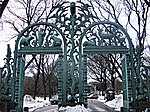Bronx Zoo

The Bronx Zoo (also historically the Bronx Zoological Park and the Bronx Zoological Gardens) is a zoo within Bronx Park in the Bronx, New York. It is one of the largest zoos in the United States by area and is the largest metropolitan zoo in the United States by area, comprising 265 acres (107 ha) of park lands and naturalistic habitats separated by the Bronx River. On average, the zoo has 2.15 million visitors each year as of 2009. The zoo's original permanent buildings, known as Astor Court, were designed as a series of Beaux-Arts pavilions grouped around the large circular sea lion pool. The Rainey Memorial Gates were designed by sculptor Paul Manship in 1934 and listed on the National Register of Historic Places in 1972.The zoo opened on November 8, 1899, featuring 843 animals in 22 exhibits. Its first director was William Temple Hornaday, who served as director for 30 years. From its inception the zoo has played a vital role in animal conservation. In 1905, the American Bison Society was created in an attempt to save the American bison from extinction, which had been depleted from tens-of-millions of animals to only a few hundred. Two years later they were successfully reintroduced into the wild. In 2007, the zoo successfully reintroduced three Chinese alligators into the wild. The breeding was a milestone in the zoo's 10-year effort to reintroduce the species to the Yangtze River in China. Today, the Bronx Zoo is world-renowned for its large and diverse animal collection, and its award-winning exhibitions. The zoo is part of an integrated system of four zoos and one aquarium managed by the Wildlife Conservation Society (WCS), and it is accredited by the Association of Zoos and Aquariums (AZA).
Excerpt from the Wikipedia article Bronx Zoo (License: CC BY-SA 3.0, Authors, Images).Bronx Zoo
Bronx River Greenway, New York The Bronx
Geographical coordinates (GPS) Address Website External links Nearby Places Show on map
Geographical coordinates (GPS)
| Latitude | Longitude |
|---|---|
| N 40.850581 ° | E -73.87538 ° |
Address
Bronx Zoo
Bronx River Greenway
10460 New York, The Bronx
New York, United States
Open on Google Maps








